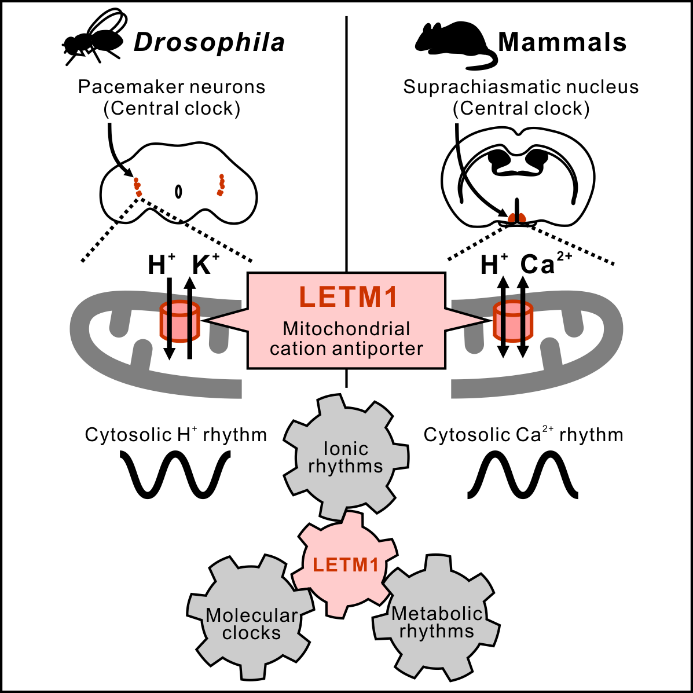Mitochondrial LETM1 drives ionic and molecular clock rhythms in circadian pacemaker neurons
Summary
A research group of Prof. Masayuki Ikeda (Graduate School of Innovative Life Science, and Organization for International Education and Exchange, University of Toyama) and Asst. Prof. Eri Morioka (Graduate School of Science and Engineering, University of Toyama) reported “Mitochondrial LETM1 drives ionic and molecular clock rhythms in circadian pacemaker neurons” under collaboration with Prof. Todd C. Holmes (University of California, Irvine). The paper showed critical functions of the mitochondrial cation antiporter (LETM1) in cytosolic H+ and Ca2+ rhythms in Drosophila and rat circadian pacemaker neurons. LETM1 knockdown disturbs clock gene oscillations in both species, clarifying mitochondrial coordination of the clock work in pacemaker neurons.
Key findings
-
- Circadian cytosolic H+ rhythms are present in lateral neurons in Drosoph
- Circadian Ca2+ rhythms are present in rat suprachiasmatic nucleus neurons.
- The mitochondrial cation antiporter (LETM1) drives these ionic rhythms.
- Clock gene oscillations in these circadian pacemakers also depend on LETM1.
Background and overview
More than 20 years ago, our group has demonstrated the presence of robust circadian rhythms in cytosolic Ca2+ concentrations in mouse hypothalamic suprachiasmatic nucleus (SCN) neurons, mammalian central circadian pacemaker neurons (Ikeda et al., 2003). The presence of robust circadian rhythms in cytosolic Ca2+ concentration is hypothesized as a common feature of oscillating cells across a wide variety of organisms, including Drosophila pacemaker neurons. Based on this hypothesis, we challenged to monitor circadian cytosolic Ca2+ rhythms in LNs in vitro; however, we failed to monitor circadian Ca2+ rhythms in LNs using the classical Yellow Cameleon Ca2+ sensor. Alternatively, the present study demonstrated presence of dynamic circadian rhythms in H+ concentration (i.e., intracellular pH) in LNs using the ratiometric H+ sensor, deGFP4.
Furthermore, in this paper, we found critical functions of mitochondrial cation antiporter, leucine zipper-EF-hand-containing transmembrane protein 1 (LETM1), which exchanges K+/H+ in Drosophila and Ca2+/H+ in mammals, in circadian pacemaker neurons. Letm1 knockdown in Drosophila pacemaker neurons reduced circadian cytosolic H+ rhythms and prolonged nuclear PERIOD/TIMELESS expression rhythms and locomotor activity rhythms. In rat pacemaker neurons in the hypothalamic suprachiasmatic nucleus (SCN), circadian rhythms in cytosolic Ca2+ and Bmal1 transcription were dampened by Letm1 knockdown. Since cation transport by LETM1 is coupled to mitochondrial energy synthesis, we propose that LETM1 integrates metabolic, ionic and molecular clock rhythms in the central clock system in both invertebrates and vertebrates (see schematic diagram on the head).
This work was supported in part by JSPS KAKENHI grant number JP16H04651, JP21K06263, JP15H06232, and JP19K16185. This work was also supported by the Naito Foundation, NIH grant R35GM127102, and JST Moonshot R&D grant JPMJMS2021.

Publication information
Journal
- Cell Reports 2022; 39: 110787
Title
Mitochondrial LETM1 drives ionic and molecular clock rhythms in circadian pacemaker neurons
Authors
Eri Morioka, Yusuke Kasuga, Yuzuki Kanda, Saki Moritama, Hayato Koizumi, Tomoko Yoshikawa, Nobuhiko Miura, Masaaki Ikeda, Haruhiro Higashida, Todd C. Holmes, Masayuki Ikeda

